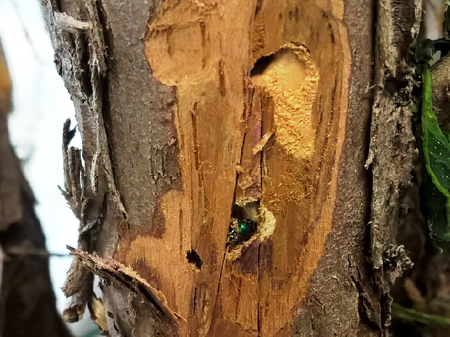Lamprodila festiva
Lamprodila festiva (synonym: Palmar festiva)
Profile
The juniper jewel beetle is a metallic green-coloured beetle that is widespread on its main host plant, the juniper. It originally comes from the Mediterranean region and has spread northwards in the course of global warming. Recently, an increasing number of cases of damage have been recorded and a further increase in damage is to be expected, especially on already weakened cypress trees.
Appearance

The metallic green shimmering jewel beetles are 6-12 mm long, streamlined and show steel blue spots on the neck shield and on the elytra.
The cream-colored larvae are 15-20 mm long, legless, and show strongly sclerotized mandibles at the anterior end. The anterior part of the thoracic segment is strongly broadened compared to the rest of the narrow body.
Biology
For oviposition, the beetles produce a short cut in the bark with their ovipositor and lay the eggs in the bast between the bark and the wood body. The feeding tunnels of the larvae are usually found on the sunny side of younger shoots and branches in the bast and superficially in the wood body. These, like the larvae themselves, have a flat oval cross-section and brown bore meal. When these tunnels completely encircle a branch, this cuts off the sap flow and the branch dies. After overwintering as a larva in deeper layers of wood, pupation occurs the next spring in a small cavity made vertically in the wood.
In early summer (around the time of the linden blossom), an adult jewel beetle hatches from this cavity, thus completing the cycle. Only one generation of beetles develops per year.
Damage symptoms
The juniper beetle causes a characteristic pattern of damage through the feeding tunnels of its larvae. In otherwise healthy looking thuja, individual branches die and turn brown. If the bark of such dead branches is cut superficially, the cause of the damage becomes visible. Between the bark and the body of the wood there are wide, shallow feeding tunnels, which are partly filled with feeding and excrement crumbs. These feeding tunnels cut off the sap flow to the twigs, and the green scale leaves dry out and turn brown. It is characteristic that only individual branches always turn brown and not the entire plant. After the beetles have hatched, the infested shoots show the typical transverse oval holes up to 5 mm in size.



Distribution
The beetle originates from the Mediterranean region and has spread northwards and eastwards in recent decades. It is a native species in the EU with a wide distribution. In addition to Austria, it is already found in Germany, the Czech Republic, Hungary, Italy, Slovenia, Switzerland and Slovakia.
Prevention and control
- As a preventative measure, ensure that the plants have a good supply of water and nutrients, as weakened plants are more likely to be infested
- Cut out and destroy heavily infested plant parts (branches, twigs) before the beetles hatch
- Treatment with chemical preparations does not appear to make sense
Last updated: 27.10.2025
automatically translated